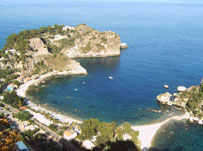Is Sicily really so different from mainland Italy?
Tuesday, 30th September 2008

Sicily (Sicilia) is an island with a population of about five million located off the southern tip of mainland Italy (Italia).
It is an autonomous region of Italy, the largest island in the Mediterraean, and has been considered a strategic location for much of it’s history. As a result, it has been occupied by many different peoples, including the Phoenicians, Greeks, Romans, Arabs, Normans and Lombards, each of whom have contributed to the unique Sicilian arts, cuisine, architecture and language.
Sicilian culture is largely rural and agriculture, particularly the cultivation of oranges and lemons, is an important part of the local economy. Sicilians are more likely to identify themselves as Sicilian rather than Italian, and feel they have more in common with the people of southern Italy and Greece than with those from others parts of Italy.
Sicilians tend to eat a lot of fish and other sea food, along with fresh vegetables and fruit such as aubergines, peppers and apricots. Sicily is also famous for its ice creams, pastries and other sweet dishes. Other well know Sicilian dishes include cannoli, a tube of fried pastry dough with a sweet filling of ricotta cheese and other ingredients. Arab influences can be seen in the use of such spices as nutmeg, clove, cinnamon and saffron. The Normans brought with them a love of meat dishes; the Spanish brought cocoa, maize, turkey and tomatoes from the New World; and the Greeks contributed a fondness for fish, olives and beans.
The Sicilian language or dialect (lu sicilianu) is another distinctive feature of Sicily. Like Italian, is a descendant of Latin, with influences from many other languages, including Phoenician, Greek, Arabic, Norman French, Lombard, Catalan and Spanish. Sicilian is used mainly in informal situations in families and between friends, and Italians from other regions only understand it to some extent.
Architecture in Sicily is very diverse with the remains of ancient Phoenician towns, Greek theatres and temples, Roman villas and palaces, Norman, Byzantine and Baroque churches, and Moorish mosques.
There are not only differences between Sicily and mainland Italy, but also between different parts of Sicily itself: the eastern part of the island has been most influenced by Greek culture, while the western part of the island has Phoenician and Arab influences. Many of the small towns are built on tops of hills - the best know example of which is Taormina, a beautiful medieval town on the east coast with wonderful views of Mount Etna and a near complete Greek/Roman theatre.
Tags: italian, food, culture, location, history, italy, destination, sicily
Posted by Simon Ager under Destinations for you,
Permalink
